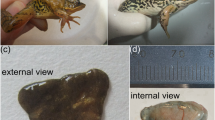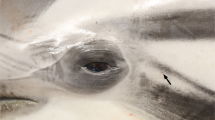Summary
The ultrastructure of the epidermal cells surrounding the mouth of three newborn marsupial species, the Northern native cat Dasyurus hallucatus, the brush tail possum Trichosurus vulpecula and the Northern brown bandicoot Isoodon macrourus were examined. The presence of Merkel cells, highly sensitive touch receptors, would suggest that the sense of touch aids the relatively underdeveloped newborn marsupial to move from the urinogenital sinus to the pouch and to locate the teat.
Similar content being viewed by others
References
Brenowitz GL, Tweedle CD, Johnson JI (1980) The development of receptors in the glabrous forepaw skin of pouch young opossums. Neuroscience 5:1303–1310
Cannon JR, Bakker HR, Bradshaw SD, McDonald IR (1976) Gravity as the sole navigational aid to the newborn quakka. Nature 259:42
English KB, Burgess PR, Kava-van Norman D (1985) Morphogenesis of Merkel cells and cutaneous type I mechanoreceptors (Haarscheiben) in rat. In: Rowe M, Willis WD (eds) Development, organization, and processing in somatosensory pathways. Alan R, Liss Inc, New York, pp 1–12
Gemmell RT (1928) Breeding bandicoots in Brisbane (Marsupialia: Peramelidae). Aust Mammal 5:187–194
Gemmell RT, Cepon G, Barnes A (1986) Weekly variations in weight and plasma testosterone concentrations in the captive male possum, Trichosurus vulpecula. Gen Comp Endocrinol 62:1–7
Hartman CG (1920) Studies in the development of the opossum Didelphys virginiana. V. The phenomena of parturition. Anat Rec 19:1–11
Hill JP, Hill WCO (1955) The growth stages of pouch young of the native cat (Dasyurus viverrinus) together with observations on the anatomy of the new born young. Trans Zool Soc London 28:349–453
Hill JP, O'Donoghue CH (1913) The reproductive cycle in the marsupial Dasyurus viverrinus. Q J Microsc Sci 59:133–174
Hughes RL, Hall LS (1984) Embryonic development in the common brushtail possum (Trichosurus vulpecula). In: Smith AP, Hume ID (eds) Possums and Gliders. Aust Mammal Soc, (Sydney) pp 197–212
Iggo A (1966) Relation of single receptor activity to parameters of stimuli. In: Renck A.V.S., Knight J (eds) Cutaneous receptors with a high sensitivity to mechanical displacement in touch, heat and pain. Churchill, London, pp 237–260
Larsell O, McCrady E Jr, Zimmermann AA (1935) Morphological and functional development of the membranous labyrinth in the opossum. J Comp Neurol 63:95–118
Lyne AG, Henrikson RC, Hollis DE (1970) Development of the epidermis of the marsupial Trichosurus vulpecula. Aust J Biol Sci 23:1067–1075
Lyne AG, Hollis DE (1971) Merkel cells in sheep epidermis during fetal development. J Ultrastruct Res 34:464–472
Lyne AG, Pilton PE, Sharman GB (1959) Oestrous cycle, gestation period and parturition in the marsupial Trichosurus vulpecula. Nature 183:622–623
McCrady E Jr (1938) The embryology of the opossum. Amer Anat Memoirs No. 16, Wistar Institute, Philadelphia
McCrady E Jr, Wever EG, Bray CW (1937) The development of hearing in the opossum. J Exp Zool 75:503–517
Merehant JC, Sharman GB (1966) Observations on the attachement of marsupial pouch young to the teats and on the rearing of pouch young by foster mothers of the same or different species. Aust J Zool 14:593–609
Montagna W, Parakkal PF (1974) The structure and function of skin. Academic Press, New York, p 89–91
Nurse CA, Mearow KM, Holmes M, Visheau B, Diamond J (1983) Merkel cell distribution in the epidermis as determined by quinacrine fluoresence. Cell Tissue Res 228:511–524
Poole WE (1975) Reproduction in the two species of grey kangaroos, Macropus giganteus (Shaw) and M. fuliginosus (Desmarest). II. Gestation, parturition and pouch life. Aust J Zool 23:333–353
Riese W (1945) Structure and function of the brain of the opossum (Didelphis virginiana) at the time of birth. J Mammal 26:148–153
Sharman GB (1959) Marsupial reproduction. Monogr Biol 8:332–368
Sharman GB (1962) The initiation and maintenance of lactation in the marsupial Trichosurus vulpecula. J Endocrinol 25:375–385
Sharman GB, Calaby JH (1964) Reproductive behaviour in the red kangaroo Megaleia rufa, in captivity. CSIRO Wildl Res 9:58–85
Author information
Authors and Affiliations
Rights and permissions
About this article
Cite this article
Gemmell, R.T., Peters, B. & Nelson, J. Ultrastructural identification of Merkel cells around the mouth of the newborn marsupial. Anat Embryol 177, 403–408 (1988). https://doi.org/10.1007/BF00304737
Accepted:
Issue Date:
DOI: https://doi.org/10.1007/BF00304737




